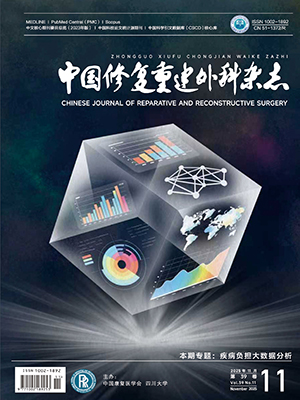Objective To compare the therapeutic effect of transforaminal lumbar interbody fusion (TLIF) and posterior lateral fusion (PLF) in treatment of thoracolumbar spine fracture and dislocation. Methods From January 2005 to July 2007, 35 patients (22 males, 13 females, aged 17-53 years old) with thoracolumbar spine fracture and dislocation (T11-L3) received posterior open reduction and pedicle nail-stick system internal fixation. Among which, 14 patients underwent TLIF
(group TLIF), and the rest 21 patients underwent PLF (group PLF). According to AO classification, group TLIF had 3 cases of A3, 7 cases of B and 4 cases of C, while group PLF had 4 cases of A3, 10 cases of B and 7 cases of C. Based on American Spinal Injury Association (ASIA) Scoring Standard formulated in 2000, the motor score of group TLIF and group PLF was (50.6 ± 3.6) and (50.8 ± 4.2) points, respectively; and the sensory score was (170.5 ± 42.7) and (153.8 ± 23.7) points, respectively. No significant difference was noted between 2 groups in general information (P gt; 0.05). Results The operation time of group TLIF and group PLF was (316 ± 32) minutes and (254 ± 27) minutes, and the blood loss of group TLIF and group PLF was (487 ± 184) mL and (373 ± 72) mL, indicating there were significant differences between 2 groups (P lt; 0.05). Wounds of all patients were healed by first intention and there was no death, aggravation of neurological function impairment and compl ication of internal fixation instrument loosening and breaking. All 35 cases were followed up for 9-23 months with an average of 14.6 months. Postoperatively, the thoracolumbar bone fusion rate of group TLIF and group PLF was 100% and 85.7%, respectively, indicating there was a significant difference (P lt; 0.05). At 3 months after operation, the motor score of group TLIF and group PLF was increased by (10.4 ± 10.0) and (9.4 ± 9.3) points, respectively; and the sensory score was upgraded by (26.5 ± 22.8) and (28.8 ± 28.4) points, respectively, showing there were no significant difference (P gt; 0.05). At immediate moment, 3, 6 and 12 months after operation, the spine height restoration of group TLIF was (5.4 ± 2.1), (5.4 ± 1.9), (5.4 ± 1.4) and (5.3 ± 1.3) mm, respectively; while it was (5.3 ± 2.6), (5.3 ± 2.2), (4.8 ± 3.1) and (4.2 ± 3.6) mm for group PLF. Meanwhile, the Cobb
angle recovery of group TLIF was (14.5 ± 3.5), (14.5 ± 3.6), (14.4 ± 3.4) and (14.4 ± 3.6)º, respectively; while it was (14.3 ± 2.7), (14.2 ± 3.1), (12.2 ± 2.8) and (11.7 ± 3.3)º for group PLF. Concerning the spine height restoration and the Cobb angle recovery, no significant difference was observed between 2 groups at immediate moment and 3 months after operation (P gt; 0.05), but significant differences were noted at 6 and 12 months after operation (P lt; 0.05). Conclusion For the treatment othoracolumbar spine fracture and dislocation, TLIF is superior to PLF in bony fusion and restoration of spine column height.
Citation: LI Tao,ZHANG Jin,SONG Yueming,LIU Hao,GONG Quan,LIU Limin,ZENG Jiancheng.. COMPARATIVE RESEARCH OF TRANSFORAMINAL LUMBAR INTERBODY FUSION AND POSTERIOR LATERALFUSION IN TREATMENT OF THORACOLUMBAR SPINE FRACTURE AND DISLOCATION. Chinese Journal of Reparative and Reconstructive Surgery, 2008, 22(11): 1330-1333. doi: Copy
Copyright © the editorial department of Chinese Journal of Reparative and Reconstructive Surgery of West China Medical Publisher. All rights reserved




